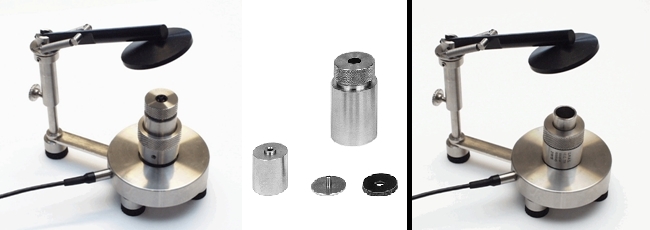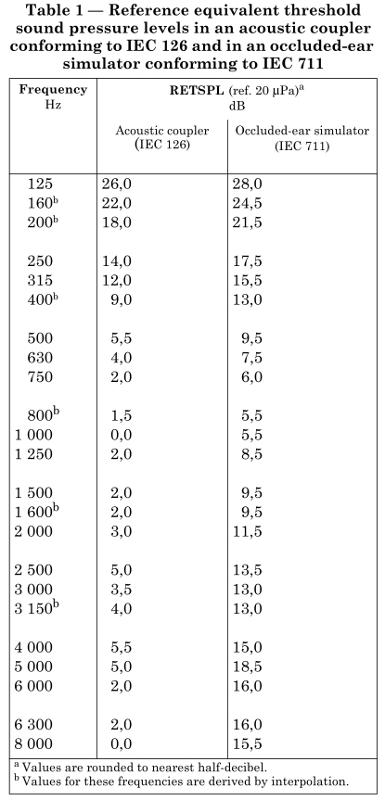Calibration of Audiometer - Pure-tone air conduction with Insert Earphones.
Equipment
For this calibration procedure basic requirements would be:
- Pure-tone audiometer with inset earphones - make sure that it is all working and that you get the expected sound out of the correct earphone
- Class 1 sound level meter
- Sound level calibrator (or pistonphone)
- Appropriate coupler (2cc coupler: BS EN 60318-5 or 2cc coupler - or occluded ear simulator: BS 6310:1982 or IEC60711, often referred to a 711 coupler)
- RETSPL values for the appropriate coupler and earphone combination (BS EN ISO 389-2)
(references given below)
Here are examples of couplers from different manufacturers - these are similar to those used in hearing-aid test boxes and come with a variety of ways of connecting to transducers - make sure you use the correct one for your insert earphones.
Figure 9 - couplers for calibrating insert earphones

Figure 8 - 2cc couplers (left) and an occluded ear simulator (right; also refered to as IEC711 coupler). The 2cc coupler is the same as those used in hearing aid test boxes and has different attachments for coupling transducers in different ways (the occluded ear simulator can also have differentattachements and the one illustrated is for the foam tip of an insert earphone).
Expected Values - RETSPLs
Once the equipment is assembled and the calibration of the SLM checked (see presentation) you need to calculate what dB SPL you could expect to get given what you set the audiometer dial to. Remember that the RETSPL is the number of dB SPL that you would expect with that coupler/headphone combination for 0 dB HL.
To ensure a good signal-noise ratio we set the audiometer to 70 dB HL
If we are using insert earphones and a IEC711 coupler (BS 6310:1982 or IEC60711) then the RETSPL values are given in the table below:
Table 2 - RETSPL values for insert earphones

Table 2 - RETSPL values for insert earphones measured on the two different couplers. Notice that the biggest differences between the two is at the higher frequencies where the occluded ear simulator is designed to more accurately mimic the acoustic impedance of a real ear.
So we know that 0dB HL at 1kHz corresponds to 5.5 dB SPL, thus for a dial reading of 70 dB HL we would expect 75.5 dB SPL
Or at 125 Hz for a dial of 70 dB HL we would expect 98 dB SPL. Because of the range of levels across frequency we may find that we have to change the range setting on the SLM.
Procedure
Now that we have the equipment set up and we know what values we should be getting we can make the measurements.
- Set up equipment
- Set SLM to dB(Z) or linear frequency response
- Check sensitivity of SLM with sound level calibrator
- Set Audiometer to 70 dB HL (can use 60 dB HL, but would need to adjust expected values)
- Listen to Audiometer to make sure signal is OK
- Connect insert earphone to coupler
- Measure sound level on SLM
- Compare measured reading with expected
- Change frequency and repeat measurements (repeat for other earphone)
- If readings more that 3dB apart then audiometer needs adjusting
References
- BS EN ISO 389-2:1997 Acoustics. Reference zero for the calibration of audiometric equipment - Part 2: Reference equivalent threshold sound pressure levels for pure tones and insert earphones
- BS EN 60318-4:2010 Electroacoustics. Simulators of human head and ear - Part 4: Occluded-ear simulator for the measurement of earphones coupled to the ear by means of ear inserts
- BS EN 60318-5:2006 Electroacoustics. Simulators of human head and ear. 2 cm3 coupler for the measurement of hearing aids and earphones coupled to the ear by means of ear inserts